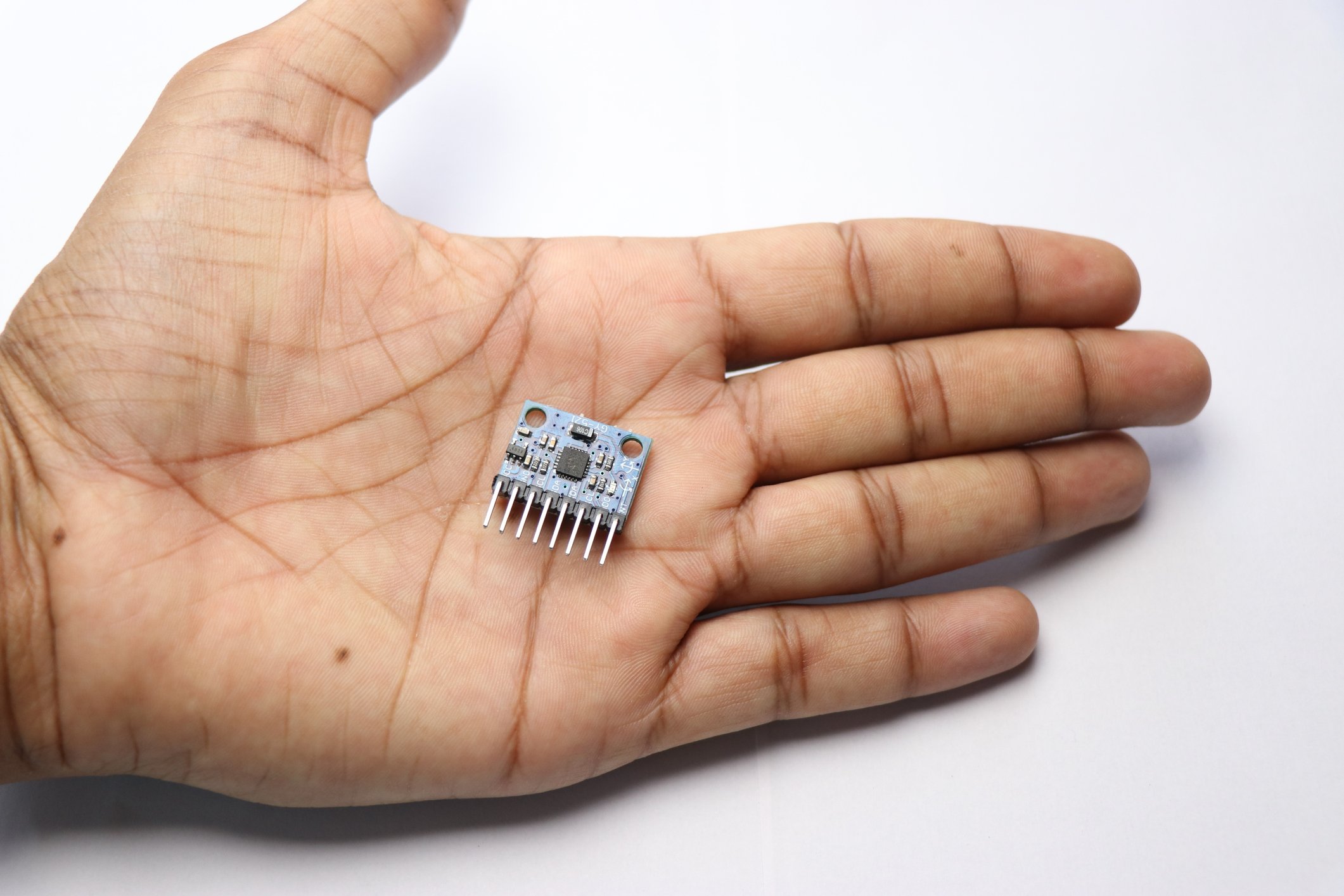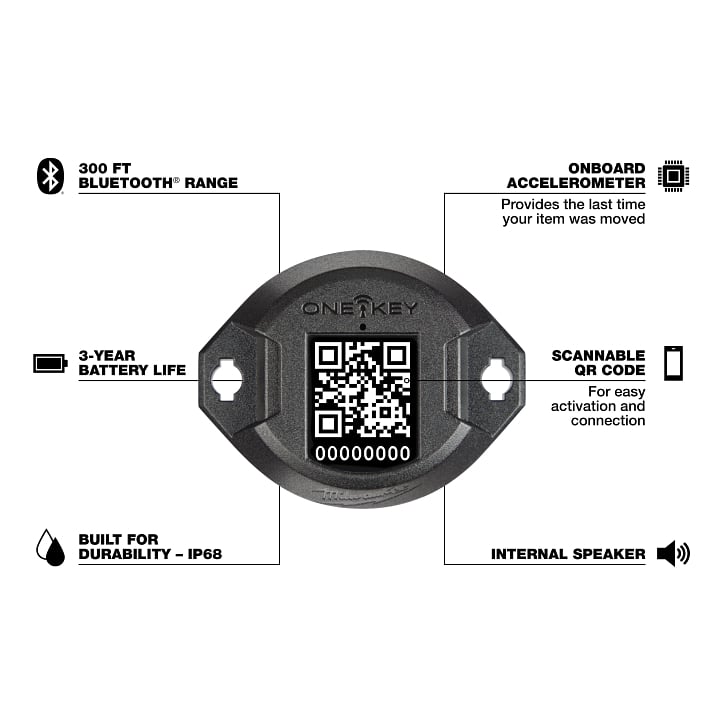
As technology has disrupted the equipment tracking space, the features available in a Bluetooth Tag have greatly expanded. The recently announced, vastly improved ONE-KEY™ Bluetooth Tracking Tag, for example, is worlds apart from the TICK™ Tool & Equipment Tracker that preceded it, released all the way back in 2017 when equipment tracking was far less sophisticated.
One such innovation is the inclusion of an accelerometer. But the functions and applications of accelerometers are far more familiar subject matter to the engineering team here at Milwaukee® Tool than they may be to the average user, apart from maybe a savvy construction technologist.
And while product demos and press releases may provide quick-and-dirty overviews of pertinent product information including tech specs at a high level, we believe that providing context behind what these features are used for is equally useful. That way you’ll have a greater understanding of not just the “what” (as in, “what features this product has”) but also the “why” (as in, “why these features matter,” or “why you should care about X feature”).
Accelerometer Definition: What Is an Accelerometer?
So, what does an accelerometer do, anyway? Accelerometers are electromechanical computer chips that, like their name suggests, measure the acceleration, vibration, and motion of a structure or device that they’re embedded within.
An accelerometer can be used to detect various aspects of motion and acceleration, including:
- Free-fall
- Wakeup
- Single/double-tap recognition
- Activity/inactivity detection
- 6D/4D orientation
Accelerometer vs Gyroscope
A gyroscope measures angular rate: The angular velocity or rotational velocity of an object; how fast an object rotates or revolves relative to another point (e.g., how quickly the angular position or physical orientation of an object changes over time).
Accelerometers and gyroscopes are often discussed in relation of each other. That’s because gyroscopes are often combined with accelerometers in a common package that allows for advanced algorithms like a sensor fusion (for orientation estimation in 3D space) to be employed.
Types of Accelerometer
There are multiple types of accelerometers that can be used for different purposes. The most common types of accelerometers include:
- Compression: A compression mode accelerometer, constructed with a crystal bonded to an internal sensing element, is typically used for scientific and industrial applications, such as predictive maintenance, aerospace, medical, automotive, and process control. They typically have a high level of rigidity, making them appropriate for withstanding harsh environments.
- Shear: As their name suggests, shear mode accelerometers stress an internal piezoelectric crystal in a “shear” rather than a compressed manner. What does that mean? With this type of sensor design, the crystals are sandwiched between a center post and a seismic mass, resulting in sheer (i.e., unaligned) forces acting on them when the accelerometer device is accelerated, similar to how a deck of cards may be pushed one way on the top, and another on the bottom, causing the cards to slide. Small in size and profile, a shear mode accelerometer provides excellent resistance to thermal interference.
- Capacitive: Capacitive accelerometers (also sometimes called mass-spring accelerometers) are semiconductor sensing devices used to sense change in electrical capacitance in response to acceleration. They are typically composed of a silicon mass attached to 4 tethers, which act as a spring system. When force is applied to one end of the mass, it moves and stretches the string, resulting in measurable displacement of the mass. 2 fixed capacitor plates and 1 separate plate are attached to the mass; the inner capacitor moves with the mass, registering a change in the capacitance relative to the fixed plates.
Additional types of accelerometers include:
- Fiber optic accelerometers, which use fiber optic sensors to measure wavelength shifts as a result of applied forces.
- Hall effect accelerometers, which convert motion into electrical signals by sensing changes in a magnetic field.
- Strain gage accelerometers, which convert the change in mass inertia into a strain measurement.
- Heat transfer devices, which sense temperature, measuring the movement and location of a heated mass.
- Magnetoresistive devices, which use a magnetic field to sense changes in material resistivity.
Accelerometer Applications: What Does an Accelerometer Do?
There are a number of applications in which an accelerometer may be used across a variety of industries. Here are some existing accelerometer applications:
- Health and medicine: In medicine, accelerometers can be used in portable defibrillators to measure chest compressions; they can be used in smart watches to determine speed and distance of a runner, or they can be used to calculate the quantity and speed of each step you take in a day; they can even be used in football helmets to measure the impact of head collisions, or to calculate a person’s gait.
- Navigation: In internal navigation systems (INS), accelerometers can be used in conjunction with gyroscopes to continuously calculate an object’s “dead reckoning,” the current position, orientation, and velocity (i.e., direction and speed of movement) of a moving object. An INS is present in a number of vehicles, such as naval ships, submarines, aircrafts, guided missiles, and spacecrafts.
- Transportation: Aside from existing within internal navigation systems, additional applications of accelerometers in the transportation sector include:
- Airbag deployment systems: These systems detect rapid deceleration; in doing so, they can determine whether a collision (and the severity of a collision) has occurred and when the airbags should be deployed.
- Electronic stability control systems: In these systems, accelerometers are used to measure cornering forces and reduce loss of traction (skidding).
- Volcanology: Accelerometers can be used in remote sensing devices that monitor active volcanoes to detect the motion of magma. This data can be used to inform the public when to evacuate an area prior to a volcanic eruption.
- Consumer electronics: Aside from the personal devices we discussed above related to health and wellness, accelerometers can be used in a number of smartphone and personal digital assistant (PDA) applications to measure user motion input. In gaming, for example, consider Sony®’s PlayStation® DualShock controllers that can be used in racecar driving games to make steering much more realistic. VR/AR smart goggles, meanwhile, may use accelerometers in conjunction with other video gaming hardware, such as controllers to detect, for example, how hard a user swings in a boxing game.
- Orientation sensing: Ever flip your phone from portrait to landscape mode when watching a video or playing a smartphone-based video game, and notice that your smartphone’s screen will automatically correct itself to the new orientation? These are accelerometers at work.
- Image stabilization: In digital cameras, accelerometers can be used to cancel out unintended motions that would otherwise cause image blurring.
Tool Tracking Application: ONE-KEY™ Bluetooth® Tracking Tag
In recent years, there have been a number of advances in the equipment tracking space allowing for a Bluetooth tag to offer far greater functionality—like near-field communication, and, yes, accelerometers. Our newly released One-Key Bluetooth Tracking Tag incorporates an onboard accelerometer to help end users access richer context about where their items were last seen by our network and, what’s more, where they were last used.

If we reflect back on our previous Bluetooth tracker, the TICK™ Tool & Equipment Tracker, a common piece of user feedback we heard about this product was the limitations it offered in delivering location information.
Critically, the new One-Key Bluetooth Tracking Tag can be used to add advanced equipment tracking capabilities to a variety of untracked items. But while the TICK provided basic Bluetooth tracking functionality to untracked items, the new Bluetooth Tracking Tag adds a greater level of granularity that wasn’t available have on TICK: The ability to see when an item was last used/moved:
- Last time your item was moved: Employing an onboard accelerometer (which we’ll discuss below) the Bluetooth tracking tag improves tool location accuracy with the capacity for more real-time updates.
Related Article: Tracking Tag vs Asset ID Tag vs TICK™: What’s the Difference?
How does the One-Key Bluetooth Tracking Tag use its accelerometer?
Tool “last used” information: In addition to being able to see when the item it’s attached to was last seen by our network, users can also now see when the item was last used up to within the last hour, and get a full location history in the last 7 days and up to the last 30 days.
How the accelerometer works:
We implemented an accelerometer in the Bluetooth tracking tag so that it will sense any movement lasting longer than around 6 seconds (4-6 seconds). Why 6 seconds? We wanted to ensure the accelerometer accurately measures movement, not capturing erroneous movement events (such as simply moving a tool a few inches). The algorithm operates under the assumption that if the tool is moving for more than 4-6 seconds, it is deliberate usage. Once the accelerometer breaches that 4-6 second threshold, it uses a different algorithm to determine if the tool is no longer being used. For that algorithm, 40 seconds with no movement is required to be considered the 'end of usage.' This was done to give the user time to do things like grab additional fasteners, change bits, etc. If someone picks up the tagged tool and carries it across the building (or worse, out of the building), this will be detected as movement. This can be helpful for preventing misplaced tools by communicating their “last used” information—it, at the same time, could be used to identify suspicious activity.
Furthermore, if the accelerometer detects the item it’s attached to is moving, it will enter a “moving state,” communicating to the app, in a sense, that “I’m being used right now,” and recording this information in the app.
This feature, previously available only on One-Key compatible tools, is now extended to any item you’d like to add a Bluetooth Tracking Tag to, adding to our commitment to comprehensive inventory management.

Wrapping Up: Accelerometers in Equipment Tracking
Accelerometers can be used in a wide variety of engineering applications to measure, maintain, and enhance acceleration in products. In the equipment tracking space, they can be used to alert end users to the most accurate and up-to-date information related to tool usage. Inventory managers and stakeholders alike will surely enjoy the increased visibility to their equipment that the new and improved One-Key Bluetooth Tracking Tag affords with its cutting-edge accelerometer use case.